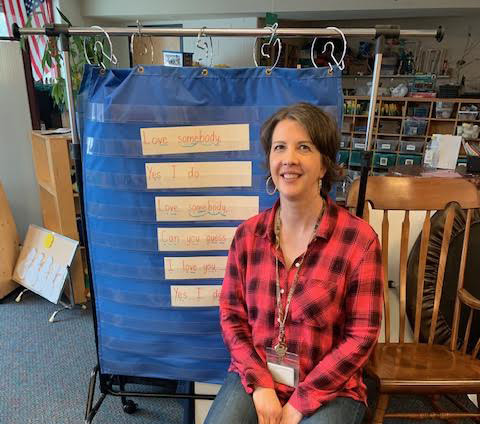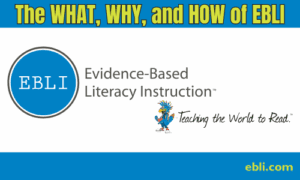“Teachers the world over are experiencing increasing awareness about the research that backs how reading should be taught – often referred to as the Science of Reading – and are shifting or completely changing their teaching practices as a result. Julie VanLier is a 21-year veteran Kindergarten Teacher who has undergone extensive self-education on the reading research and dramatically changed her reading, spelling, and writing instruction as a result. I would like to enthusiastically welcome Julie, a dedicated, determined, exceptional EBLI teacher, as our first guest blogger.” – Nora Chahbazi
The following guest blog and accompanying video were written and recorded by Kindergarten Teacher Julie VanLier (pictured here):

My journey into structured literacy began in August 2019. A few years prior, I moved from a highly affluent school to a high poverty school (in the same district), and my Acadience scores plummeted. Through a series of fortunate events, I attended an EBLI training, paying for it with my own money. I left the workshop overwhelmed and full of doubt. EBLI went against EVERYTHING I had learned from my college classes, the educational books I read, and the professional development in my district.
Because EBLI didn’t align with my educational beliefs, I ignored it. I had been taught that it is developmentally easier for kindergartners to write capital letters rather than lowercase ones. That we should first teach kids to read environmental print (ie, McDonald’s arches for “McDonalds”) to boost their confidence. That we need to spend months teaching rhyming, compound words, and syllables.
When I finally got around to teaching EBLI (though I disguised it in our schedule chart so my principal wouldn’t know I was using a different curriculum), I was astonished. My kiddos were blending words together to read and segmenting words to write – and it was only the end of September! I typically hadn’t taught those phonemic awareness skills until January! I had zero behavior problems during the 45 minute lessons, and everyone was engaged. This is highly unusual for a classroom full of 26 four and five year olds! At first, I taught EBLI for my phonics lessons, but the rest of my Language Arts block remained the same: I sent my kids off to “read” during reading workshop, “write” during writing workshop, and then I “reinforced” those concepts during centers. It was almost as though I were trying to drive with one foot on the brake and one foot on the gas pedal: Explicitly teaching kids how to read and write during phonics but then I’d send them off to construct their own knowledge during workshop time. I’m sure this sent kids conflicting messages: “During writing time, guess how to spell a word, but during phonics say each sound and write the correct spelling for that sound”. This made no sense!
As teachers, we need to do a better job of using our critical thinking skills when planning and teaching. First, our curriculum and teaching methods need to be research aligned instead of based on personal beliefs. Although cognitive scientists figured out decades ago how the brain learns to read, teachers still cling tightly to their own beliefs. I would NEVER choose a doctor who practiced medicine using debunked methods, so why is this actually encouraged in education?
Second, teachers need to stop being the “guide on the side”. There is nothing natural about learning to read and write. It took civilization thousands of years to create our alphabet system yet we believe that kids can figure it out by themselves in two to three years. We need to deliver explicit, systematic instruction and stop thinking that our students will reach grade level standards by being turned loose to construct their own knowledge.
Third, we need to quit wasting instructional time. What will students truly learn from doing all those seat work activities from Teachers Pay Teachers? Or the countless “learning” songs on You Tube? The National Reading Panel says there are five pillars to effective reading instruction: phonemic awareness, phonics, fluency, vocabulary, and comprehension. We have too much to do (and don’t forget math, science, and social studies) to fill our day with useless activities that don’t accelerate learning.
There is a saying, “you don’t know what you don’t know.” But, once you realize that YOU are the one who is causing kids to fail, then it is time for you to be gutsy enough to say no to outdated practices and say yes to embracing practices that teach all kids to be proficient readers and writers.





